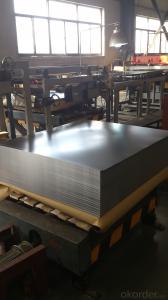TIN FREE STEEL FOR MAKING CROWN CORK
- Loading Port:
- China Main Port
- Payment Terms:
- TT OR LC
- Min Order Qty:
- -
- Supply Capability:
- -
OKorder Service Pledge
Quality Product, Order Online Tracking, Timely Delivery
OKorder Financial Service
Credit Rating, Credit Services, Credit Purchasing
You Might Also Like
We are professionally supply Tin Free Steel and Tin Free Steel Sheet in China.
The Tinplate specification as following:
1.Reference standard:GB/T24180-2009;JIS G3315-2008
2.Material:SPCC/MR
3.Thickness avaiable:0.15mm to 0.36mm
4.Width available:600mm to 1050mm
5.Temper grade:T2-T5/DR8 BA and CA both
6.Coil weight:3-10T
7.Sheet weight:1-3T
8.Chrome coating weight:70-150mg/㎡
9.Package:Anti-rust paper,corner protected,by sheet or coils according customer's require.
- Q:What are the advancements in tinplate technology?
- Some of the advancements in tinplate technology include improved coatings for enhanced corrosion resistance, the development of thinner and lighter tinplate materials, and the introduction of advanced printing techniques for more vibrant and detailed designs. Additionally, there have been advancements in tinplate manufacturing processes, such as continuous annealing and tin-free steel alternatives, which have improved production efficiency and reduced environmental impact.
- Q:How is tinplate affected by exposure to light?
- Tinplate is not significantly affected by exposure to light. It is a durable material that can withstand various environmental conditions, including light exposure, without any major changes or deterioration.
- Q:What are the advantages of using tinplate for electrical enclosures?
- There are several advantages to using tinplate for electrical enclosures. Firstly, tinplate is highly resistant to corrosion, which helps protect the sensitive electrical components inside the enclosure from moisture and other environmental factors. Secondly, tinplate offers excellent electrical conductivity, ensuring efficient flow of electricity and minimizing any potential interference or loss. Additionally, tinplate is a lightweight material, making it easier to handle and install. Lastly, tinplate is also recyclable, making it an eco-friendly choice for electrical enclosures.
- Q:Can tinplate be used for chemical packaging?
- Yes, tinplate can be used for chemical packaging. Tinplate is a type of steel coated with a layer of tin, which provides a protective barrier against corrosion and contamination. This makes it suitable for storing and transporting various chemicals safely. Additionally, tinplate is a durable and lightweight material, making it an ideal choice for chemical packaging.
- Q:How do you clean the dust and trace oil on tin containers?
- Water based cleaning method: that is, with clean water and cleaning agent to remove oil method, the use of water washing process. This process started relatively late in the country, and the technical strength of various manufacturers formula is uneven, of which the more representative of public praise is "evergreen peak" brand CLF water-based cleaning agent series.
- Q:What is the recycling process for tinplate?
- The recycling process for tinplate typically involves collecting the tinplate packaging, separating it from other materials, such as paper or plastic, and then shredding or melting it down to remove any coatings or impurities. The clean tinplate is then compressed into bales or melted into molten metal, which can be used to produce new tinplate products.
- Q:What are the different methods of printing on tinplate?
- There are several methods of printing on tinplate, including lithography, screen printing, and digital printing. Lithography involves transferring an image onto a metal plate, which is then used to print onto the tinplate. Screen printing uses a mesh screen to apply ink onto the tinplate through open areas of the screen. Digital printing utilizes computer-controlled printers to directly apply ink onto the tinplate, allowing for greater flexibility and detailed designs.
- Q:What are the different types of tinplate surface treatments?
- There are several types of tinplate surface treatments, including electrolytic tinplate (ETP), tin-free steel (TFS), blackplate, and lacquered tinplate.
- Q:What are the different types of tinplate edge finishes?
- There are three main types of tinplate edge finishes: single edge, double edge, and scroll edge.
- Q:What are the different types of tinplate lamination?
- There are primarily two types of tinplate lamination: single-sided lamination and double-sided lamination. In single-sided lamination, only one side of the tinplate is laminated with a protective layer, typically made of a polymer or lacquer. On the other hand, double-sided lamination involves laminating both sides of the tinplate, providing enhanced protection and barrier properties.
1. Manufacturer Overview |
|
|---|---|
| Location | |
| Year Established | |
| Annual Output Value | |
| Main Markets | |
| Company Certifications | |
2. Manufacturer Certificates |
|
|---|---|
| a) Certification Name | |
| Range | |
| Reference | |
| Validity Period | |
3. Manufacturer Capability |
|
|---|---|
| a)Trade Capacity | |
| Nearest Port | |
| Export Percentage | |
| No.of Employees in Trade Department | |
| Language Spoken: | |
| b)Factory Information | |
| Factory Size: | |
| No. of Production Lines | |
| Contract Manufacturing | |
| Product Price Range | |
Send your message to us
TIN FREE STEEL FOR MAKING CROWN CORK
- Loading Port:
- China Main Port
- Payment Terms:
- TT OR LC
- Min Order Qty:
- -
- Supply Capability:
- -
OKorder Service Pledge
Quality Product, Order Online Tracking, Timely Delivery
OKorder Financial Service
Credit Rating, Credit Services, Credit Purchasing
Similar products
New products
Hot products
Related keywords




























